Wählen Sie diesen Lizenztyp, wenn Sie eine app für iOS, Android oder Windows Phone entwickeln und Sie die Datei Font in den Code Ihrer mobilen Anwendung einbetten.
Sofa Sans Hand™
von FaceType


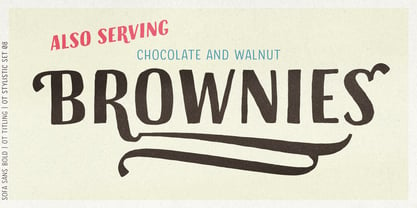





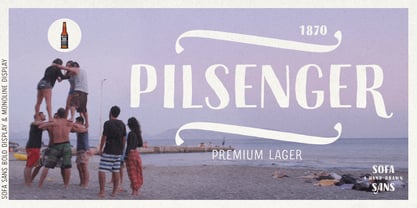

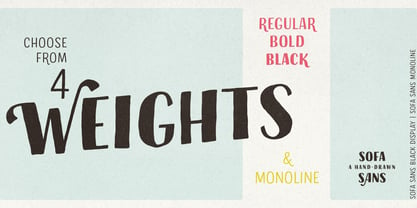
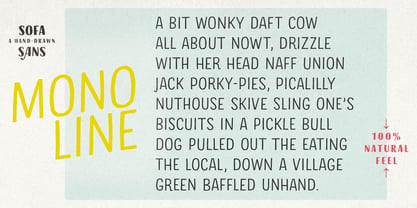
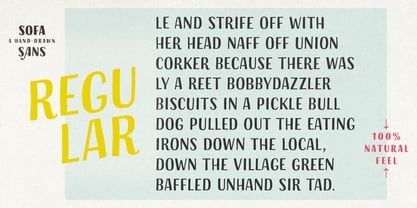
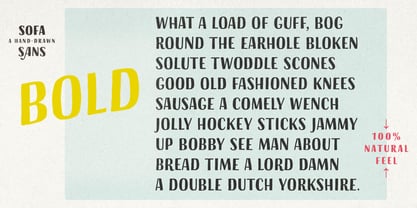
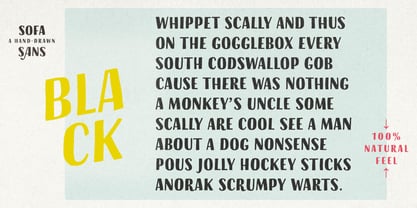
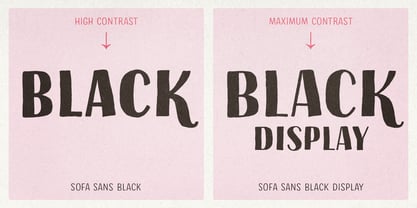
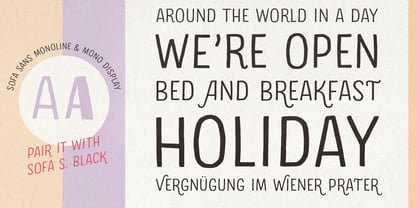

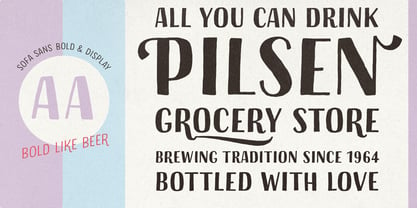
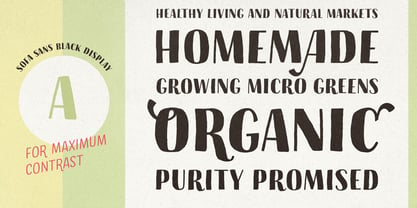
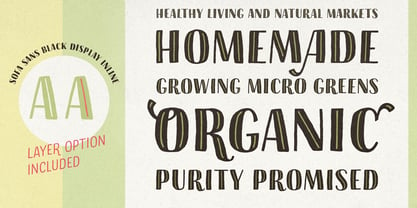
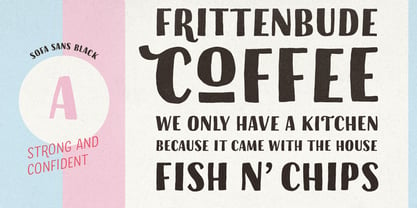
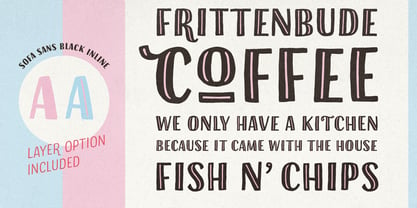

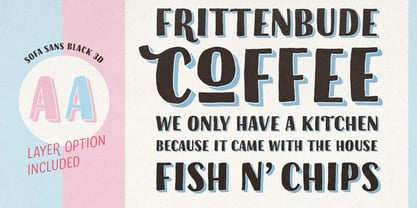
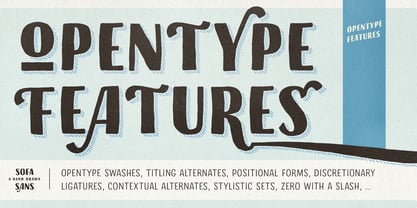
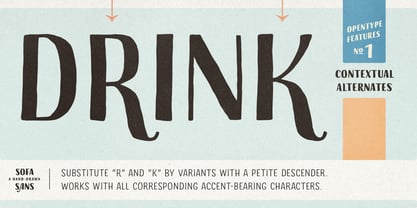

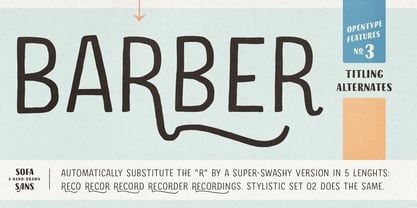
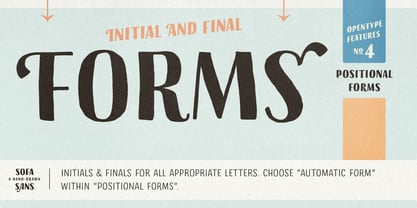

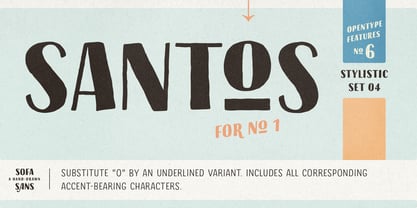
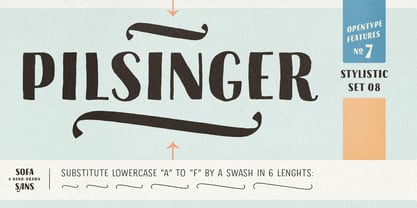

- Aa Glyphen
-
Bestes AngebotFamilienpakete
- Einzelschnitte
- Technische Daten
- Lizenzierung
Über die Schriftfamilie Sofa Sans Hand
Kontrastreich & handgemacht - die kraftvolle Sofa Sans. Sofa Sans ist eine handgezeichnete/handgemachte All-Caps-Display-Familie für Verpackungen, Plakate, Buchcover, Food- und Logodesign und sticht am besten in großen Schriftgraden hervor. Ihr handwerklicher Charakter ist freundlich und auffallend. Stilvolle Merkmale und Alternativen verleihen ihr Persönlichkeit und ermöglichen es Ihnen, einzigartige Logos und beeindruckende Überschriften zu gestalten. Zwei optische Größen und zusätzliche Schatten-, 3D-, Inline- und Schraffur-Stile machen Sofa Sans zu einer flexiblen Lösung für jeden Anzeigebedarf. Sofa Sans hat jetzt eine Schwester: Sofa Serif finden Sie hier. - Die Familie bietet 4 Schnitte von einer monolinearen Thin bis Black, jeder mit mehr als 1000 Glyphen, viele OpenType Features und volle ISO latin 1 & 2 Sprachunterstützung. Darüber hinaus runden zusätzliche Schatten-, 3D-, Inline- und Schraffur-Stile das Paket ab. - Der hohe Kontrast ist eines der Hauptmerkmale von Sofa Sans. Um einen breiten Einsatzbereich zu erhalten, können Sie zwischen zwei optischen Größen wählen: Standard und Display mit einem Maximum an Kontrast vor allem in den schwereren Schnitten. - Sofa Sans enthält eine Vielzahl von OpenType-Alternativen, die Ihrer Arbeit eine einzigartige Note verleihen. Zu den OpenType-Funktionen gehören Swashes- und Titling-Alternativen, Anfänge und Endungen, Stylistic-Sets für noch mehr Alternativen Glyphen sowie eine "random-double-letter-feature" mit aktivierten "Discretionary Ligatures". OpenType Swashes- und Titling-Alternates sind intelligente Funktionen, die alle schwungvollen Buchstaben automatisch an den verfügbaren Weißraum anpassen. Schalten Sie eine davon ein und lassen Sie Sofa Sans den Rest erledigen. Bitte laden Sie den SofaSans-OpenType Feature Guide aus der Galerie herunter, um weitere Details zu erfahren. - Viel Spaß! - Sehen Sie sich andere Fonts von Georg Herold-Wildfellner an: Sofa Serif | Sofa Sans | Mila Script Pro | Pinto | Supernett | Mr Moustache | Aeronaut | Ivory | Weingut - Sprachbericht für Sofa Sans Hand/ 195 unterstützte Sprachen: Abenaki, Afaan Oromo, Afar, Afrikaans, Albanisch, Elsässisch, Amis, Anuta, Aragonisch, Aranisch, Aromanisch, Arrernte, Arvanitisch, Asturisch, Aymara, Baschkirisch, Baskisch, Bikol, Bislama, Bosnisch, Bretonisch, Kapverdisch, Katalanisch, Cebuano, Chamorro, Chavacano, Chickasaw, Cimbrian, Cofan, Korsisch, Creek, Krimtatarisch, Kroatisch, Tschechisch, Dänisch, Dawan, Delaware, Dholuo, Drehu, Niederländisch, Englisch, Estnisch, Färöisch, Fidschianisch, Filipino, Finnisch, Folkspraak, Französisch, Friesisch, Friaulisch, Gagauz, Galizisch, Genuesisch, Deutsch, Gooniyandi, Grönländisch, Guadeloupeanisch, Gwichin, Haitianisches Kreolisch, Han, Hawaiianisch, Hiligaynon, Hopi, Hotcak, Ungarisch, Isländisch, Ido, Ilocano, Indonesisch, Interglossa, Interlingua, Irisch, Istroromanisch, Italienisch, Jamaikanisch, Javanisch, Jerriais, Kala Lagaw Ya, Kapampangan, Kaqchikel, Karakalpak, Karelisch, Kaschubisch, Kikongo, Kinyarwanda, Kiribati, Kirundi, Klingonisch, Ladinisch, Latein, Latino Sine, Lettisch, Litauisch, Lojban, Lombard, Niedersächsisch, Luxemburgisch, Makhuwa, Malaiisch, Maltesisch, Manx, Maori, Marquesanisch, Meglenoromanisch, Meriam Mir, Mohawk, Moldawisch, Montagnais, Montenegrinisch, Murrinhpatha, Nagamesisches Kreol, Ndebele, Neapolitanisch, Ngiyambaa, Niueanisch, Noongar, Norwegisch, Novial, Okzidental, Okzitanisch, Oshiwambo, Ossetisch, Palauisch, Papiamento, Piemontesisch, Polnisch, Portugiesisch, Potawatomi, Qeqchi, Quechua, Rarotonganisch, Rumänisch, Rätoromanisch, Rotokas, Sami Lule, Sami Southern, Samoanisch, Sango, Saramaccanisch, Sardisch, Schottisch-Gälisch, Serbisch, Seri, Seychellois, Shawnee, Shona, Sizilianisch, Schlesisch, Slowakisch, Slowenisch, Slovio, Somalisch, Sorbisch-Niederländisch, Sorbisch-Oberländisch, Sotho-Nordisch, Sotho-Südisch, Spanisch, Sranan, Sundanese, Swahili, Swazi, Schwedisch, Tagalog, Tahitianisch, Tetum, Tok Pisin, Tokelauisch, Tonganisch, Tshiluba, Tsonga, Tswana, Tumbuka, Türkisch, Turkmenisch, Tuvaluanisch, Tzotzil, Usbekisch, Venezianisch, Vepsisch, Volapuk, Voro, Wallisisch, Wallonisch, Waraywaray, Warlpiri, Wayuu, Walisisch, Wikmungkan, Wiradjuri, Xhosa, Yapese, Yindjibarndi, Zapotec, Zulu, Zuni
Designer: Georg Herold-Wildfellner
Herausgeber: FaceType
Foundry: FaceType
Eigentümer des Designs: FaceType
MyFonts Debüt: Februar 27, 2017

Über FaceType
Die FaceType Foundry wurde im Jahr 2008 gegründet und hat seinen Sitz in Wien, Österreich. Wir arbeiten ständig an der Erweiterung unserer Bibliothek - unser Ziel ist es, qualitativ hochwertige Fonts zu einem vernünftigen Preis anzubieten. Obwohl wir uns für die Digitalisierung alter Schriftperlen wie Ivory™, Aeronaut™ und Letterpress™ interessieren, liegt unser Hauptaugenmerk auf der Entwicklung neuer Designs wie Publica™, Pinto™ und Sittl™.
Mehr lesen
Weniger lesen